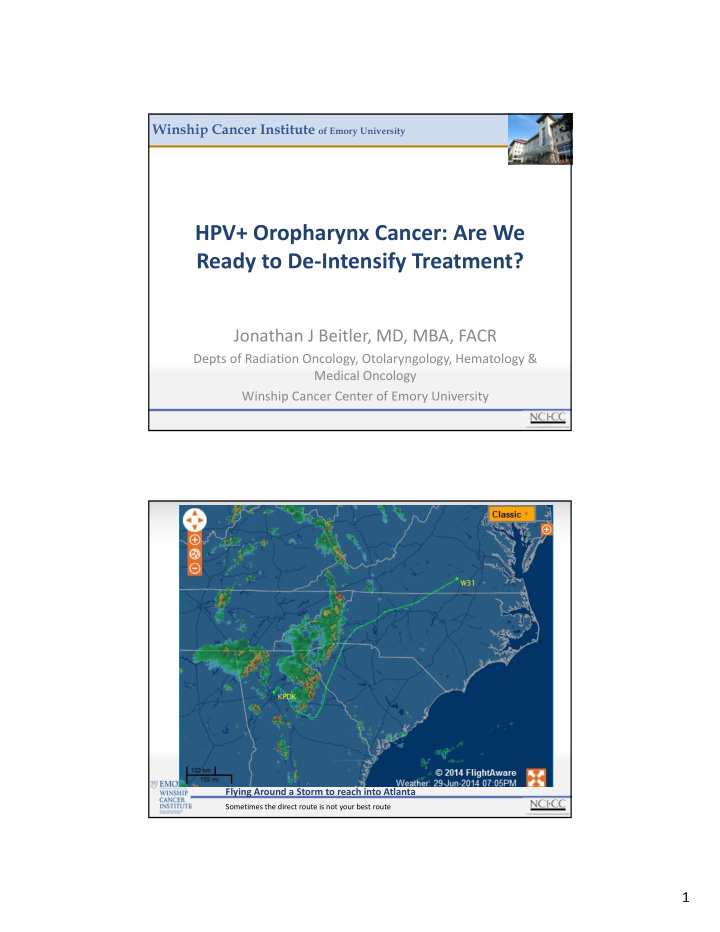



Winship Cancer Institute of Emory University HPV+ Oropharynx Cancer: Are We Ready to De ‐ Intensify Treatment? Jonathan J Beitler, MD, MBA, FACR Depts of Radiation Oncology, Otolaryngology, Hematology & Medical Oncology Winship Cancer Center of Emory University Flying Around a Storm to reach into Atlanta Sometimes the direct route is not your best route 1
What is Oropharyngeal cancer • Anatomically distinct from oral cavity cancers • Classically treated with radiation ‐ based approaches • Classically associated with smoking/alcohol risk factors • 5 ‐ year survival rates 43 ‐ 58% Paradigm shift: De ‐ intensification • Intergroup: 70Gy vs 70Gy+cisplatin vs splitcourse ‐ chemoRT • RTOG 0129: 70Gy+cisplatin vs Accel70Gy+cisplatin • RTOG 0522: Accel70 Gy+cisplatin vs Accel70Gy+cisplatin+cetuximab • RTOG 1016: Accel70 Gy+cisplatin vs Accel70Gy+cetuximab – closing 2014 • NRG HN002: In development, based on principles of de ‐ intensification 2
(Ang, Harris et al. 2010) RTOG 0129, Con Boost What is P16 • Cyclin ‐ dependent kinase (CDK) inhibitor • Inactivates CDKs that phosphorylate retinoblastoma (Rb) • HPV oncoprotein E7 binds and inactivates Rb, causing upregulation of p16 • Immunohistochemical stain • Cheap and readily optimized for clinical labs • Has become the surrogate marker for HPV – and a selection criterion in RTOG clinical trials 3
Acute Toxicity Burden of current chemoradiation approach Platinum based Chemoradiotherapy Estimated for Bioradiotherapy RT alone Trotti A et al. Lancet Oncol 2007; Long ‐ term morbidity of full ‐ dose chemoradiation • Swallowing dysfunction • Pharyngeal strictures • Xerostomia and dental effects • Chronic pain • Osteoradionecrosis/chondroradionecrosis • Particularly germane because HPV+ OPC patients are 15 years younger than other HN cancer patients 4
What Can We DO? • 1) Decrease chemotherapy a) Less toxic chemotherapy b) Radiation Alone c) Surgery alone and Surgery + prn XRT/chemo • 2) Decrease the XRT – Induction Chemo and Chemo Selection ‐ E1308 • 3) New Trials – TORS – HN01 RTOG 1016 a)Less Toxic Chemotherapy 5
RTOG 1016 a)Less Toxic Chemotherapy • Primary Objective ‐ 5 Year Survival • Opened June 2011 – After a hiatus the study was enlarged to 1,000 patients to allow for 834 eligible patients • Waiting for 45 events…. – The study is doing well… b) Radiation Alone 6
PMH XRT Alone b) Radiation Alone Natural History of HPV Disease +HPV ‐ HPV 7
b) Radiation Alone • The Distant Control rates for +HPV low risk patients (T1 ‐ T3, N0 ‐ N2a, or less than 10 pack year N2b) was… similar between RT and CRT alone • MD Anderson ‐ Similar • Would keep T3 out of LR group c)Surgery alone 8
Surgery + prn XRT/Chemo 38% avoided chemotherapy and 11% avoided XRT Arch Otolaryngol Head Neck Surg. 2010;136(11):1079 ‐ 1085 Lots of Enthusiasm(2012) 9
2013 Data on PFS are premature. A 2 year PFS of 85% or better will be considered worthy of further study 10
2014 Median Follow up was 23.4 months. This is from time of registration and Includes three 21 ‐ day cycles of induction chemo and 2 ‐ 3 weeks for assesstment Of response….Possible lead time bias? 3 Months At 23 months, ECOG 1308 just MISSED it’s target A 2 year PFS of 85% or better will be considered worthy of further study 11
24 ECOG 3311 P16+ Trial – Low Risk OPSCC: Personalized Adjuvant Therapy Based on Pathologic Staging of Surgically Excised HPV+ Oropharynx Cancer LOW RISK: T1-T2N0-N1 Observation negative margins Assess Eligibility : Radiation Therapy HPV (p16) + IMRT 50Gy/25 Fx SCC R oropharynx A INTERMEDIATE: N Evaluate for 2-yr PFS Stage III-IV: Clear margins Transoral Resection D Local-Regional cT1-3, N1-2b (any approach) ≤ 1 mm ECS O Recurrence, Functional 2–3 metastatic LN (no T1N1) with neck dissection M Outcomes/QOL PNI I LVI Baseline Z E Functional/ Radiation Therapy QOL IMRT 60 Gy/30 Fx Assessment HIGH RISK: Positive Margins > 1 mm ECS or Radiation Therapy ≥ 4 metastatic LN IMRT 66 Gy/33 Fx + CDDP 40 mg/m 2 wkly 12
NRG HN002: A Randomized Phase II Trial for Patients with P16 Positive, Non ‐ Smoking Associated, Locoregionally Advanced Oropharyngeal Cancer R S R Eligibility 60 Gy XRT (2Gy/fx) E T A in 6 weeks + • OP SCCA Central Declare G R review Intent N • ≤ 10 pack ‐ cisplatin 40 mg/m2 I A year p16+ Unilat D weekly x 6 cycles • T1 ‐ T2 N1 ‐ S IHC T vs O N2b T I Bilat • T3 N0 ‐ M Neck E F N2b 60 Gy XRT (2 Gy/fx) XRT I R Y at 6 fractions/week Z for 5 weeks 44% of RTOG 1016 E population eligible Waiting Until Hurricane Arthur Had Passed Sometimes time clears the air…. 13
Recommend
More recommend